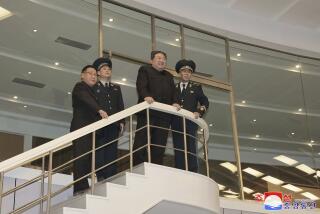Shuttle to Carry Spy Satellite, Magazine Says
- Share via
KENNEDY SPACE CENTER, Fla. — The secret space shuttle mission scheduled for later this month will carry an intelligence-gathering satellite that will cover 80% of the Soviet Union, an industry magazine reported Friday.
“When fully deployed, the spacecraft will have a span as large as 150 feet,” Aviation Week and Space Technology reported. “It has the characteristics of an imaging radar or optical reconnaissance involving digital imaging, or both.
“The radar transmission is designed to penetrate cloud cover and would be valuable in both ocean and land surveillance,” the magazine said in its Nov. 7 issue, which was available Friday.
NASA Silent on Mission
Because of the military nature of the mission, the National Aeronautics and Space Administration and the Pentagon have refused to disclose most details about it. NASA official Conrad Nagel said the agency was aiming for a launching on Nov. 28 or 29.
The publication said that the shuttle Atlantis and its five-man crew will be launched into an orbit that will cover most of the Soviet Union. At least three of the 27 earlier shuttle missions flew over the same Soviet territory.
The magazine said that the satellite will be dropped overboard by an astronaut using the craft’s 50-foot robot arm. Two astronauts are prepared to take a space walk in case there is trouble in deploying the satellite, said sources who asked not to be identified.
$500-Million Vehicle
Aviation Week reported that estimates of the cost of the satellite, filled with advanced technology equipment, range as high as $500 million. It said the spacecraft could be retrieved on a later shuttle mission and returned to Earth for improvements.
Sources who insisted on anonymity earlier had told the Associated Press that Atlantis would carry an intelligence-gathering satellite that would help American intelligence officials verify that the Soviets were complying with arms control treaties.
The sources said also that the astronauts will conduct several experiments aimed at defining man’s role as a military observer in space. The tests would involve coordination with troop and ship movements and missile launchings on Earth.
More to Read
Sign up for Essential California
The most important California stories and recommendations in your inbox every morning.
You may occasionally receive promotional content from the Los Angeles Times.










